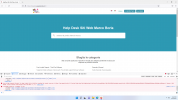PeopleInside
Regular Pleskian
Hi, I have recently moved to Plesk and I have an issue:
There I have an Help Desk Ticket platform: HelpDesk HelpDesk Siti Web Marco Borla where on the right bottom should be showed a live chat widget that is blocked (Browser Developer Console) with the error: Multi-origin request blocked (cross-origin)
I have not this issue only at this helpdesk address but same issue also on my other website Marco Borla | .:. Marco Borla .:. IT where the same live chat widget is blocked.
How can I resolve?
Thank you.
I have already visited the following guide: https://support.plesk.com/hc/en-us/...s-origin-resource-sharing-in-Plesk-for-Linux- but is not helping, not resolving the issue.
There I have an Help Desk Ticket platform: HelpDesk HelpDesk Siti Web Marco Borla where on the right bottom should be showed a live chat widget that is blocked (Browser Developer Console) with the error: Multi-origin request blocked (cross-origin)
I have not this issue only at this helpdesk address but same issue also on my other website Marco Borla | .:. Marco Borla .:. IT where the same live chat widget is blocked.
How can I resolve?
Thank you.
I have already visited the following guide: https://support.plesk.com/hc/en-us/...s-origin-resource-sharing-in-Plesk-for-Linux- but is not helping, not resolving the issue.



